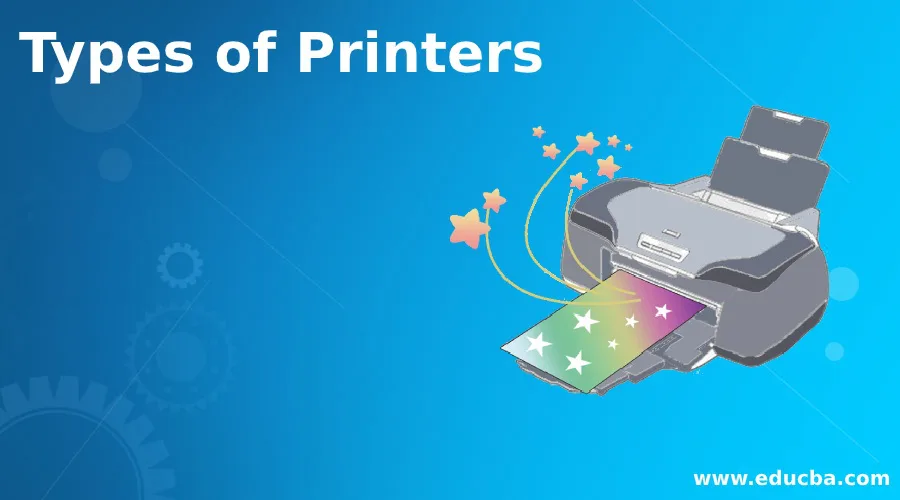
Introduction to Types of Printers
The following article provides an outline for Types of Printers. A printer is a hardware output device for hard copying and printing any paper. A document of any kind can be a picture, text file, or a combination of either. It accepts a command of users to print the documents on a computer or other devices. You must, for instance, create a softer copy of your reports and print it using the printer, if you need to submit a project report at their university. Printers are the most popular portable computer devices that can be separated into 3D printers and 2D printers groups. 2D printers are being used for printing of paper text and graphics and 3D printers for the development of physical objects in three dimensions.
Various Types of Printers
Given below are the various types :
1. Laser Printers
Laser printers are one of the most common electronic printers. It began in 1971 and was founded at Xerox PARC by Gary Starkweather. The technology for printing text and images uses laser photocopier. Whenever some paper is written, a laser beam draws it with an electric charge on the selenium-coated base. It is rolled into toner when the drum is charged. The ink follows the picture on the drum. The tin is mixed with the paper and then spread over a sheet of paper, including heat and pressure.
2. 3D Printers
The 3d printer, developed in 1984 by Chuck Hull, is one of the best improvements in the history of printed technology. It manufactures 3D objects and objects with resin quality. It uses materials such as polymers, plastics, metal alloys, and foods. 3D printers are used for numerous applications, such as IT, archaeology, dentistry, biotechnology, and aerospace engineering. It could be, for example, used to physically rebuild ancient archaeological artifacts that have been destroyed over time.
3. LED Printers
Most like a laser printer, the LED printing is. It prints the black and colored documents using inks, fuser system, and drum. In the beginning, Casio and the LED printers were developed by concentrating light on their entire drum length. Such kinds of printers do not affect, but they use a light-emitting diode rather than a laser in the printhead. In 1989, the manufacturer OKI invented these printers. LED printers and Laser printers differ the LEDs use an ink tray of LEDs to create a static charge for the printer while laser printers use a laser and a mirror. Although LED printers are not more popular than laser and inkjet printers, they are gaining popularity because they offer unique benefits to users.
4. Solid Ink Printers
A solid ink laser class printer is designed to save packaging money and space. The technology is a unique type of tinting, which is previously melted into a fluid. Although inkjet printers directly stream into the paper, solid ink printers are different when the ink is poured into the drum. The first way to get a good color combination is to move the incense to the drum instead of the printer, as the drum can properly be operated over the moving paper. In 2000, Xerox acquired Tektronix, Inc. color printing division, Tektronix, Ink. and its pencil like cartridges have launched the solid ink printer on the market.
5. Dot Matrix Printers
The dot matrix printers are also known as the 1957 IBM released pin printer. In 1970 the first dot-matrix impact printer was created by Centronics. He hits an ink band using print heads to form images and text by putting thousands of small dots. It is currently less used in comparison to inkjet printers and laser, as its printing speed is sluggish and produces lower image quality. However, in some industries, such as the shipping firms and car parts shops, dot matrix printers tend to be in use.
6. Thermal Printer
Jack Kilby, also known as an electrothermal printer, thermal transfer printer, or thermal wax transfer impression, invents a thermal printer. It uses heated pins to render the picture on paper. These kinds of printers are used extensively in finance, food, transportation, entertainment, retail, fax, education, and computing machines. These printers can be low-cost and easily printed and do not use ink as other printing presses do. The image processing depends primarily on the thermal paper. Popular Course in this categoryAll in One Software Development Bundle (600+ Courses, 50+ projects)600+ Online Courses | 3000+ Hours | Verifiable Certificates | Lifetime Access
4.6 (3,144 ratings)Course Price
₹8999 ₹125000
View Course
Related CoursesWindows 10 Training (4 Courses, 4+ Projects)JWS Java Web Services Training (4 Courses, 11 Projects)Java Training (40 Courses, 29 Projects, 4 Quizzes)
7. Plotter
A plotter is hardware or printer that Remington-Rand first developed in 1953. This is used to print vector graphics and methods for drawing continuous lines using a pen, pencil, marker, or other writing devices rather than ink or tonner. It is usually used to print a hard copy of schemes and others.
Recommended Articles
This is a guide to Types of Printers. Here we discuss the introduction to printers along with various types. You may also have a look at the following articles to learn more –
